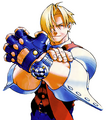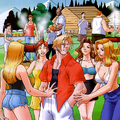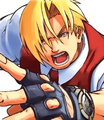Roy Bromwell (ロイ・ブロムウェル Roi Buromuweru) is a United States foreign exchange student from the games Rival Schools: United By Fate and Project Justice.
Biography
Roy, the "Strong-Armed American"
Roy is the star quarterback of an unbeatable American football team seen as an idol by fellow male students in his home country. He's capricious, sometimes less than serious, and tries more than anyone else just to look sharp. Nonetheless, he is a frank person who dislikes cowardice. His hatred for Japan and its people stem from the fact that his grandfather would constantly tell him of how he lost his leg during the Second World War.
Appearance
Roy has short blonde hair with long fringes on both sides of his hair and has two upper fringes in the center of his head.
His primary outfit was a red formal vest under a long sleeve white buttoned shirt which is folded below to his mid-arm with a long red tie on the collar of his button shirt. He wears a black belt to his waist, denim pants and black and red sneakers. Like Batsu, he also wears a black fingerless gloves and wears a silver watch on his left wrist.
In his in-game appearance, he is not seen wearing a black belt and the silver watch to his wrist.
Story
Rival Schools: United By Fate
Roy is first introduced in Rival Schools: United By Fate. A rich foreign exchange student from the United States, he is often portrayed in the games as main character Batsu's rival.
In the first game, he is ordered to investigate the school kidnappings by his father, with Tiffany and Boman joining him. During their investigation, the American trio is defeated and brainwashed to the service of Justice High, but eventually is freed thanks to Batsu and his Taiyo High compatriots. This causes Roy eventually rethink his ideas about Japan and its people. His ending in the game has him return to the United States determined to change the way of thinking in his home country, and 30 years after the games take place, he is elected President of the United States.
Project Justice
In Project Justice, Roy, along with Tiffany, returns to Japan when the new school conflict breaks out. They show up in two of the storylines in the game; either helping Batsu and his friends in the Taiyo High story, or joining up with Boman in the Pacific High story. The Pacific High ending has him return to the United States with Tiffany, more determined to change the world.
Arsenal, combat style, and fighting strategy
Due to the fact that Roy is an American football player, a number of his in-game special moves are modeled and named after elements of the sport. Several of his moves bear a striking resemblance to SNK's Terry Bogard.
(Analogy: Touchdown wave--Power wave; Twister--Rising tackle; Dynamite straight--Burning Knuckles)
Special Moves
- Dynamite Straight (ダイナマイトストレート) - This is Roy's main special attack, wherein he delivers a fast charging punch that knocks the opponent a good distance away from him. It is very powerful, and its recovery delay is almost negligible. This move has an aerial version, which is as follows:
- Air Dynamite (エアダイナマイト) - Aerial version of the Dynamite Straight, and is an excellent Air Combo finisher. This has two versions:
Version One
Roy does a forward-rolling Dynamite Punch that knocks the opponent to the ground.
Version Two
Roy does a twirling Dynamite Punch that knocks the opponent away from him. The twirl is done in a similar fashion to Hinata's Sunrise Punch.
The latter is more powerful, but the former has higher chances of hitting the opponent; Roy will yell "I got it!" while executing either version of this move, as well as Dynamite Straight.
- Twister Upper (ツイスターアッパー) - Roy does a forward-jumping spinning uppercut. This is good as a Tardy Counter and an anti-air attack. Roy, however, is completely vulnerable to counterattacks while he is landing from the jump.
- Touchdown Wave (タッチダウンウェーブ) - Roy punches the ground, generating a column of energy directly in front of him. If it hits, it sends the opponent into the air. Because it has fast recovery, it is a better anti-air attack than Twister Upper. It may hit once or thrice, depending on the punch button pressed for this attack's button combination. If the player is fast enough, he can immediately follow with an Air Combo, but this is very hard to accomplish.
Burning Vigor Attacks
- Super Touchdown (スーパータッチダウン) - Powered version of the Touchdown Wave. Roy jumps forward and punches the ground, generating three columns of energy, each one generated in front of its precedent after the preceding wave dissipates. Startup is somewhat slow, and will entirely miss if done directly in front of the opponent.
- Triple Twister (トリプルツイスター) - Roy does three Twister Uppers. More hits can be scored by repeatedly pressing the punch button for this attack's button combination. It also has the same drawbacks as the Twister Upper, so it must be used with caution.
- Dynamite Justice (ダイナマイトジャスティス) - Roy does a football tackle, followed by a Dynamite Straight that knocks the opponent into a random obstacle in the field, scoring a bonus hit. If all hits connect, this does massive damage. An excellent Tardy Counter that has fast startup and nearly negligible recovery delay.
Team-Up Technique
- Double Rising Tornado (Wライジングトルネード) - Roy and the active character do a vertical Twister Upper to the opponent. Of all the Team-Up techniques, this has the fastest startup; but if blocked, the opponent has ample time for a Tardy Counter.
Party-Up Technique
- Roy does the Triple Heaven's Cross.
Trivia
- Roy lives alone in his father's holiday villa. In his home country, he lives with his parents and two older sisters, whose names and lifestyles remain undisclosed to this day.
- Aside from American football, Roy is also good in arm wrestling, in which he has a rival in Boman.
- He has no need for part-time jobs; after all, his family is wealthy.
- He has satisfactory performance in almost any subject in school; there is no subject where he shows below-average academic performance.
- During the translation phase for United by Fate, some of Roy's lines included English expletives that were removed prior to international release. Players with a keen ear, however, can hear them, since no English voice work was done. Other than that, his lines in the first game show how highly rude he was towards Japan and its people. In one instance, he called Hideo a 'Japanese businessman', but the English script had him call the teacher a 'geek'. On top of that, he refers to Japan as 'Batsu's country'. In Project Justice, there had been no translation problems whatsoever regarding Roy, since it has been assessed that none of his lines were highly rude, due to the fact that his perception of Japan and its people has changed.
- Roy, Tiffany and Boman are the only non-Japanese playable characters in the Rival Schools games.
- As explained above, Roy and several of his moves bear a striking resemblance to SNK's Terry Bogard.
- Some of his moves may be based from that of Zero from the Mega Man X games, also produced by Capcom. One version of his Air Dynamite is roughly based on Zero's rolling slash techniques, while his Touchdown Wave and Super Touchdown involve punching the ground, similar to how Zero punches the ground to perform Giga Attacks. Moreover, both characters are voiced by Ryōtarō Okiayu.
Gallery
References
Game and Character Information
Nguyen, John. Project Justice FAQ/Move List by Puar. GameFAQs.com. Published 2001. Last accessed 14 March 2010.
Tsai, Peter. FAQ/Movelist for Project Justice (Moero! Justice Gakuen) for Dreamcast/Arcade. Version 1.07. GameFAQs.com. Published 17 July 2002; last updated 13 March 2003. Last accessed 14 March 2010.
Cheshire, Sophie. Project Justice: FAQ/Move List by falsehead. Final version. GameFAQs.com. Published 5 November 2001; final update 7 December 2002. Last accessed 14 March 2010.
Batsu, the Doctor of Punishment. Shiritsu Justice Gakuen/Rival Schools series: Character Stories FAQ. Version 1.5 (final). GameFAQs.com. Last accessed 14 March 2010.
NeoChaosX. List of characters in the Rival Schools series. Wikipedia (English). Created 20 August 2007; last updated 30 March 2010. Last accessed 1 April 2010.
Translations
Kanji translations made possible through the Kanji Romaji Hiragana Convert website.
Maruyama, Chiemi. English-Kanji-Japanese/Japanese-Kanji-English Dictionary. Pasig City, Philippines: Persian Gulf Publication, 2002. ISBN 978-971-8796-37.
Nakao, Seigo. Random House Japanese-English/English-Japanese Dictionary. United States: Ballantine Books, 1995. ISBN 0-345-40548-X.




